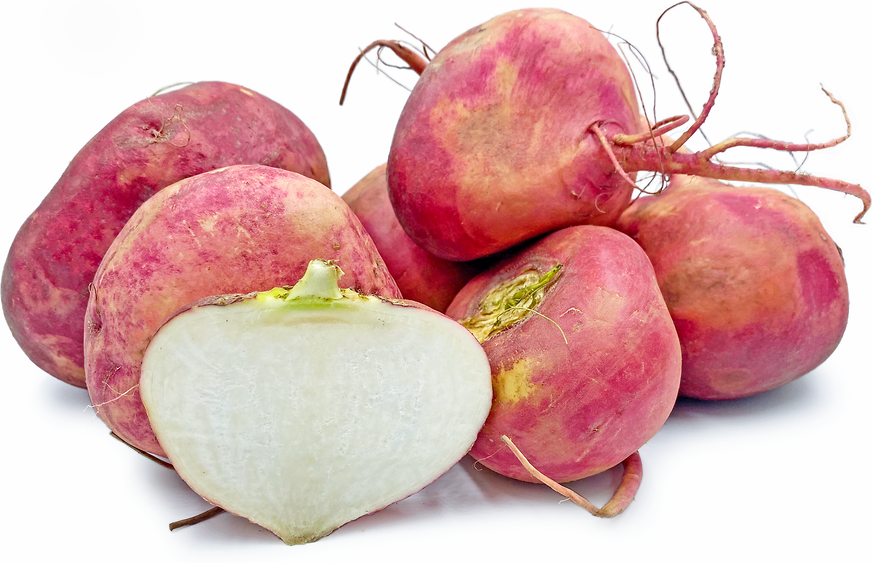


Red Sun Turnips
Estimated Inventory, lb : 0
Description/Taste
Red Sun turnips are small to medium-sized roots with an ovate, globular, to slightly flattened shape and an elongated, slender taproot extending from the non-stem end. The skin is semi-smooth and firm, bearing many variegated, red-pink hues. Underneath the surface, the flesh is crisp, aqueous, and pale white to cream-colored with a mild, earthy aroma. Red Sun turnips have a high sugar content creating a neutral, sweet flavor, and is lacking bitterness commonly associated with the roots.
Seasons/Availability
Red Sun turnips are available in the late summer through winter in Asia and Europe.
Current Facts
Red Sun turnips, botanically classified as Brassica rapa, are a sweet root that belongs to the Brassicaceae or mustard family. Considered to be a Japanese variety, Red Sun turnips were developed for their edible, non-bitter flesh and have the unique characteristic of being able to be consumed raw without prior cooking. Red Sun turnips are a specialty home garden variety that is favored for its durability, flavor, fast-growing nature, and high productivity. The turnips can be utilized in a wide variety of both raw and cooked applications, and its sweet taste develops into a rich, savory flavor when cooked.
Nutritional Value
Red Sun turnips are an excellent source of vitamin C, which is an antioxidant that can protect and boost the immune system. The roots also contain some fiber, calcium, vitamins A and K, and iron.
Applications
Red Sun turnips are best suited for both raw and cooked applications such as steaming, roasting, boiling, and sautéing. The sweet and tender flesh makes these roots unique from other turnip varieties as they can be consumed raw and do not require peeling. The fresh roots can be sliced and added into green salads, grated and served over grain bowls, and thinly sliced and mixed into slaws. The turnips can also be lightly sautéed for a rich, buttery flavor, roasted with other root vegetables, tossed into stews and soups, cooked and mashed as a side dish, sliced into casseroles, or pickled for extended use. In addition to the roots, the leaves can also be lightly cooked and served as an accompaniment to the roots. Red Sun turnips pair well with apples, pears, carrots, potatoes, onions, cheeses such as parmesan, cheddar, and gruyere, meats such as poultry, pork, beef, and turkey, spices such as coriander, nutmeg, and paprika, and rice. Fresh turnips will keep 4-5 months when stored whole and unwashed in the crisper drawer of the refrigerator.
Ethnic/Cultural Info
In Russia, turnips were one of the main sources of food up until the potato’s introduction in the 19th century. Russians valued the hardy root, and the turnip became a source of inspiration for folk tales, games, and expressions. Known as “The Giant Turnip” folk tale, the Russian story tells of an old man trying to pull up a very large turnip and requires the assistance of an old woman, a granddaughter, a dog, a cat, and a mouse to finally pull the root out. The story has been told in different variations throughout the country for hundreds of years and was meant to illustrate that there is value in everyone, no matter their size. The folk tale was so beloved that it was even turned into an arcade game known as the “Repka Silomer,” or “The Turnip Strength Tester,” which tests the strength of the player by squeezing a lever. Depending on the force used on the lever, the player is given a strength score related to the characters in the folk tale and is told whether or not they were strong enough to uproot the turnip.
Geography/History
Turnips are believed to be native to regions of Asia and Europe and have been grown since ancient times. As cultivation increased across the two continents, new varieties were created to meet changing market demands and usability. Red Sun turnips are a Japanese variety that was created in the 1950s in Japan. Developed and selectively bred from original turnip varieties to have a sweeter flavor, Japanese turnips quickly spread across Asia and Europe, where they became a popular home garden variety. Today Red Sun turnips can be found through local markets in Asia and Europe and are also sold through online seed catalogs for home garden use.














